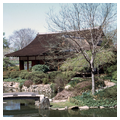Fairmount Park was created to protect the city's water supply and in competition with New York City's Central Park. Roads were laid out beginning in 1859, following plans conceived by James C. Sidney, a British-born landscape architect, and his American partner Andrew Adams. Their scheme provided a framework for the later park and connected the various attractions, such as the park houses including Richard Peters's pre-Revolutionary Belmont Mansion and Lemon Hill ( PH132), which were adapted in the post–Civil War years to serve as public restaurants. Unlike Central Park that was conceived as “the lungs of the city,” Fairmount Park was distant enough to be largely controlled by the elite for their activities until professional rowing captured a larger public. Long before the park was conceived, the mechanical and architectural marvel of the Fairmount Water Works ( PH130) drew crowds to witness its water-powered system pump the Schuylkill's waters to the vast reservoir that became the base for the Art Museum.
You are here
Fairmount Park
1812; 1859, James C. Sidney and Andrew Adams; 1867, Hermann Schwarzmann. E. River Dr. (Kelly Ave.) and W. River Dr.
If SAH Archipedia has been useful to you, please consider supporting it.
SAH Archipedia tells the story of the United States through its buildings, landscapes, and cities. This freely available resource empowers the public with authoritative knowledge that deepens their understanding and appreciation of the built environment. But the Society of Architectural Historians, which created SAH Archipedia with University of Virginia Press, needs your support to maintain the high-caliber research, writing, photography, cartography, editing, design, and programming that make SAH Archipedia a trusted online resource available to all who value the history of place, heritage tourism, and learning.







